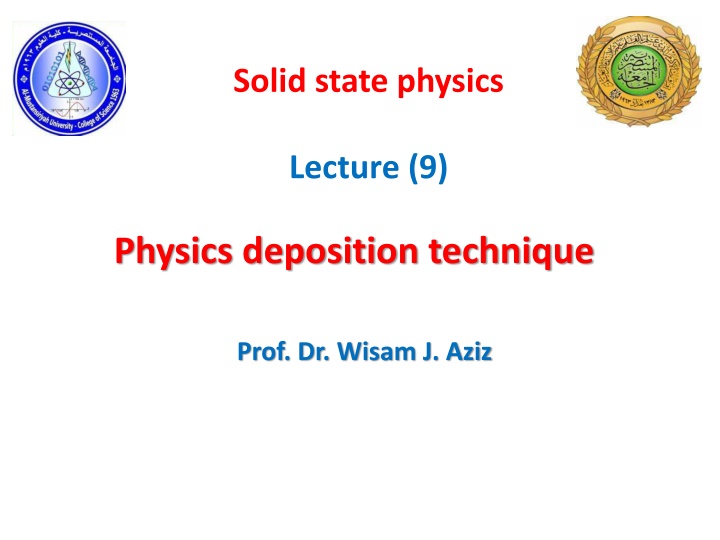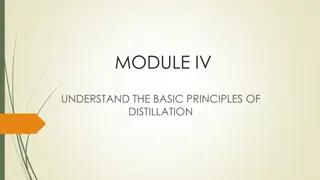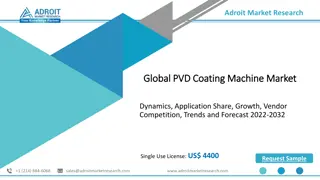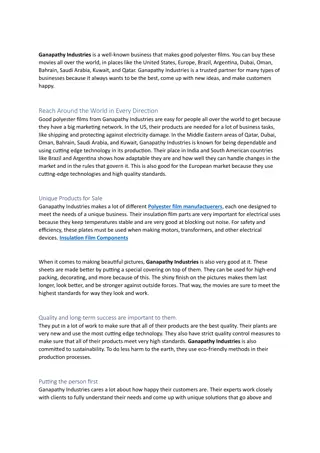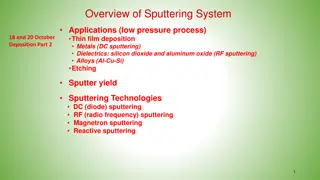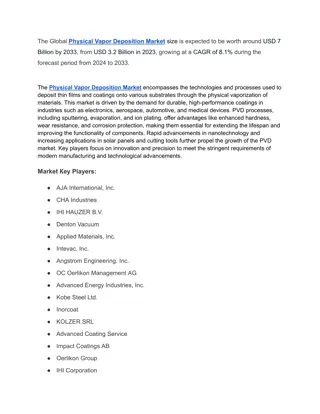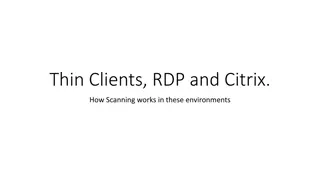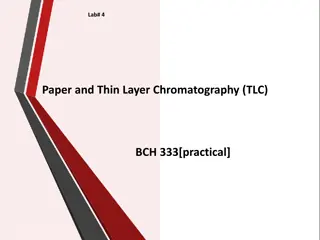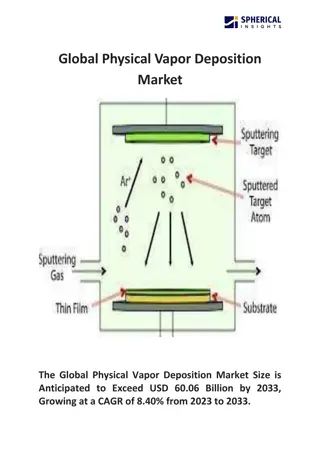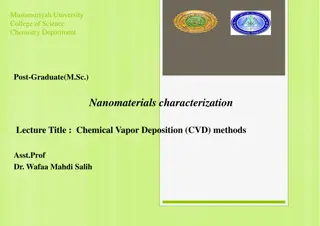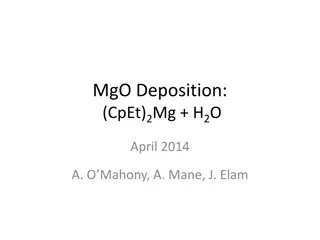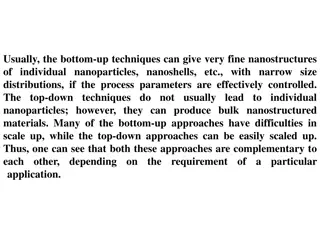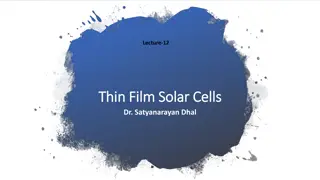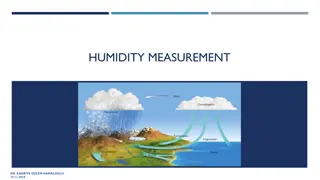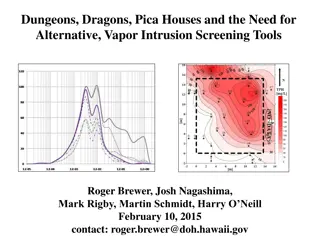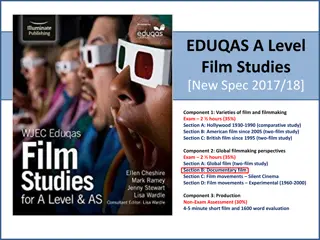Overview of Physical Vapor Deposition (PVD) Techniques in Thin Film Deposition
Physical Vapor Deposition (PVD) includes various vacuum techniques for depositing thin films on substrates through physical means. This method involves a dry vacuum process to coat objects with different materials. PVD processes utilize methods like Mechanical, Evaporation, Sputtering, Ion plating, and Pulse laser for producing metal vapor and plasma. Evaporation, such as Thermal Evaporation, is a common technique where a vapor is generated by evaporating a source material, condensing into a solid film on a substrate. The deposition system typically consists of a nozzle sprayer, heater, temperature controller, chamber with a ventilator, and air compressor.
Download Presentation

Please find below an Image/Link to download the presentation.
The content on the website is provided AS IS for your information and personal use only. It may not be sold, licensed, or shared on other websites without obtaining consent from the author.If you encounter any issues during the download, it is possible that the publisher has removed the file from their server.
You are allowed to download the files provided on this website for personal or commercial use, subject to the condition that they are used lawfully. All files are the property of their respective owners.
The content on the website is provided AS IS for your information and personal use only. It may not be sold, licensed, or shared on other websites without obtaining consent from the author.
E N D
Presentation Transcript
Solid state physics Lecture (9) Physics deposition technique Prof. Dr. Wisam J. Aziz
Physical Vapor Deposition (PVD): PVD encompasses a group of vacuum techniques used for depositing thin films of different materials onto various substrates by physical means. process is a dry vacuum deposition method to coat an entire object (or substrate) at once. The PVD reactive processes are a common method for depositing a hard coating of metal. They combine an active gas, such as nitrogen, oxygen, or methane with the plasma bombardment of the substrate. The main difference of PVD methods is the way they produce the metal vapor and the plasma. . In general, it can be categorized into the following groups: 1- Mechanical 2- Evaporation 3- Sputtering 4- Ion plating 5- Pulse laser ( PLD and PLA)
1- Mechanical (milling) method This method produces mechanical Nano-materials in powder form, where material is placed under a very high energy and milling by balls made of stainless . can be made Powder up in size from 3- 25 (nanometer).
2- Evaporation Evaporation E-beam evaporation Thermal evaporation MBE
Evaporation: is one of the most common methods of thin film deposition. Although it is one of the oldest physical techniques, it is still widely used in the laboratory and in industry. In this process, a vapor is generated by evaporating or subliming a source material, which is subsequently condensed as a solid film on a substrate. 2.1. Thermal evaporation In thermal evaporation, the target material is melted and evaporated or sublimed using an electric resistance heater. In this process, the vapor pressure in the chamber (Figure bellow) is raised from the initially very low pressure to one that allows the material to be deposited on the substrate. This initial high vacuum is necessary because it allows the vapor to reach the substrate without reacting with or scattering by other atoms in the chamber.
The deposition system consists of: 1. nozzle sprayer with (0.1-0.8)mm inner diameter and inlet for carrier gas (N2). 2. Heater (hot plate), for heating substrate. It is used for controlling the temperature of the substrate in which the film deposit on it 3. Temperature controller. It is use for measuring the temperature of heater and substrate .It connected with a digital counter to measure the temperature. 4. Chamber with ventilator. 5. Air compressor or gas propellant.
2. Electron beam evaporation In this method, an electron gun is used for evaporation. It consists of a heated filament for electron emission. The filament is normally shielded to prevent any sputtering by vapor species and gaseous ions. An electron beam is accelerated through potential of 5 to 10 KV and focused on the material. The electrons lose their kinetic energy mostly as heat. The temperature of the evaporant material can be raised by electron bombardment instead of resistive heating. extremely high rates of evaporation achieved even for high melting point materials. The advantages of this deposition method are the material utilization efficiency is high as compared to other deposition methods. This process offers structural and morphological control of films.
2.2 Molecular beam epitaxial (MBE) It is one of the most significant thin film deposition techniques in nanotechnology. It is a technique that grows atomically thick layers. Its slow deposition rate allows the films to grow epitaxial. MBE is conducted by creating a molecular beam of the source material that it wish to deposit. This beam then impinges on the substrate where it is deposited atom by atom. In MBE, the evaporated atoms (beam) do not interact with each other or any other vacuum chamber gases until they reach the substrate, due to the beam s large mean free path length, which is a result of the ultra high vacuum (10 8 - 10 12torr). The beam can be shuttered in a fraction of a second, allowing for almost abrupt transitions from one material to another.
MBE is widely employed for producing epitaxial layers of metals, insulators and superconductors. The most important aspect of MBE is the deposition rate less than 3000 nm per hour that allows the films to grow epitaxially. These deposition rates require proportionally better vacuum to achieve the same impurity levels as other deposition techniques. The absence of carrier gases as well as the ultra high vacuum environment results in the highest achievable purity of the grown films. In solid source MBE, elements such as gallium and arsenic, in ultra-pure form, are heated in separate quasi-Knudsen effusion cells or electron beam evaporators until they begin to slowly sublime. The gaseous elements then condense on the wafer. During operation, reflection high energy electron diffraction (RHEED) is often used for monitoring the growth of the crystal layers. A computer controls shutters in front of each furnace, allowing precise control of the thickness of each layer.
2.3 Sputtering Is a physical vapor deposition (PVD) method of thin film deposition by sputtering. This involves ejecting material from a "target" that is a source onto a "substrate". Sputtered atoms ejected from the target have a wide energy distribution, typically up to tens of eV. In sputtering, the target material and the substrate is placed in a vacuum chamber. A voltage is applied between them so that the target is the cathode and the substrate is attached to the anode. Plasma is created by ionizing a sputtering gas (generally a chemically inert, heavy gas like Argon). The sputtering gas bombards the target and sputters off the material we d like to deposit.
DC or Direct Current Sputtering is a Thin Film (PVD) Coating technique where a target material to be used as the coating is bombarded with ionized gas molecules causing atoms to be Sputtered of into the plasma. These vaporized atoms are then deposited when they condense as a thin film on the substrate to be coated. the power supply is simply a high-voltage DC source. and the Deposition rate changes with Ar pressure increases with sputter yield usually increases with high voltage. DC Sputtering is the most basic and inexpensive type of sputtering for PVD metal deposition and electrically conductive target coating materials. Two major advantages of DC as a power source for this process is that it is easy to control and is a low cost option if you are doing metal deposition for coating.
RF sputtering : In RF sputtering, source of power is AC (Alternating Current). Instead of DC voltage to cathode, apply a voltage oscillating at radio frequency (RF), typically around 13.56 MHz.. In RF sputtering there are a cathode (the target) and a anode, in series with a blocking capacitor (C). The capacitor is part of an impedance-matching network that proves the power transfer from the RF source to the plasma discharge. RF-sputtering offers advantages over DC; in particular sputtering of an electrically insulating target become possible. The difference between RF sputtering and DC sputtering that : (1) RF power is suitable for all the materials applicable for both the insulator and the conductance targets materials while DC sputtering works with metals or conductive targets. (2) RF sputtering chamber pressure is 0.5 to 10 mTorr while DC sputtering is usually 1 to 100 mTorr. (3) Deposition rate is low compare to DC sputtering. (4) It is used for smaller substrate sizes compare to DC sputtering. (5) Deposition rate is low compare to DC sputtering.
4-Ion Plating This technique is classed between thermal evaporation and sputtering. It employs an electron beam evaporator to evaporate the target material (chromium or titanium). At the same time plasma is also generated near the substrates. After the evaporated particles pass through plasma, some of them become ionized and sputtering effects takes place on the substrate surface. This produces highly energetic ions of the target material near the substrate. As these ions can be implanted deeper in the surface of the substrate, the adhesion of thin films to the substrate surface is greatly increased.
5- Pulse Laser 5.1 Pulse Laser Deposition (PLD) is a thin film deposition technique in which the target material is ablated by a focused laser beam that is periodically pulsed. This process is generally conducted in a high vacuum (less than 10-7torr). The source material is transformed from a solid to plasma by consecutive pulses of the focused laser light. Due to thermal expansion, this plasma is directed perpendicularly away from the source s surface towards the substrate. The plasma is cooled due to its expansion and consequently it transforms to a gas. However as the process is carried out at low pressure, the gas has enough momentum to reach the substrate, where it condenses to form a solid thin film. Thin films produced by PLD can be well controlled as the parameters of the laser can be accurately altered.
Advantages Better surface coverage than other methods (Physical vapor deposition, Sputter deposition). More energy available on the surface of the bombarding species, resulting in more complete bonding. Flexibility with the level of ion bombardment. Improved chemical reactions when supplying plasma and energy to surface of the bombarding species.
Disadvantages Increased variables to take into account when compared to other techniques. Uniformity of plating not always consistent Excessive heating to the substrate Compressive stress Is ion plating durable? Ion plating is very durable compared to traditional techniques. Experimentation has shown that this new method can be five to eight times more durable.
Pulsed laser deposition (PLD) is a physical vapor deposition (PVD) technique where pulsed laser beam is focused inside a vacuum chamber to strike a target of the material that is to be deposited. This material is vaporized from the target (in a plasma plume) which deposits it as a thin film on a substrate (such as a silicon wafer facing the target). a high-power
Pulse Laser Ablation (PLA) is the process of removing material from a solid (or occasionally liquid) surface by irradiating it with a laser beam. At low laser flux, the material is heated by the absorbed laser energy and evaporates or sublimates. At high laser flux, the material is typically converted to a plasma. Usually, laser ablation refers to removing material with a pulsed laser, but it is possible to ablate material with a continuous wave laser beam if the laser intensity is high enough. Nd:YAG or Excimer lasers of deep ultra-violet light are mainly used in ablation; the wavelength of laser used in ablation is approximately 200 nm.
Some advantages of PLA (i) a chemically simple and clean synthesis, the final product is Usually obtained without by products and no need for further purification. (ii) Low cost of experimental setup and easily controlled parameters. (iii) the extreme confined conditions and induced high temperature, high pressure region favor the formation of unusual metastable phases. These advantages allow the designer to combine selected solid targets and liquid to fabricate compound nanostructures with desired functions.
